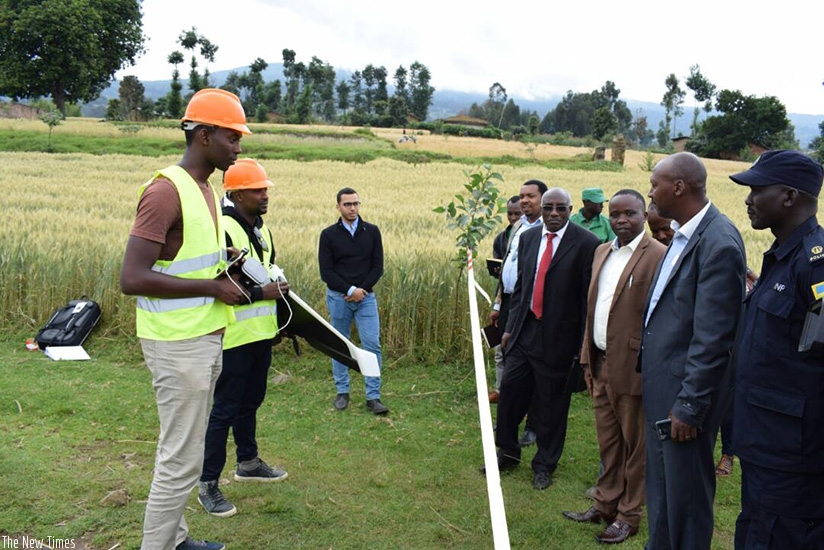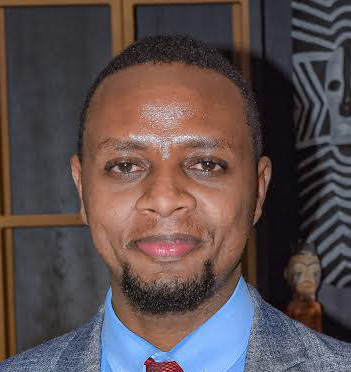It’s a Thursday morning in a rural village of Musanze District, where a team of government officials has joined members of Charis Unmanned Aerial Solutions as they demonstrate the potential of drones in driving agriculture.


It’s a Thursday morning in a rural village of Musanze District, where a team of government officials has joined members of Charis Unmanned Aerial Solutions as they demonstrate the potential of drones in driving agriculture.
Everyone in the area is eagerly waiting to see what happens, including those from close neighborhoods come to have a glimpse of these small and remotely piloted vehicles meant to change the way we do business.
Within a brink of an eye, the drone takes off to start its mission plan.
Teddy Segore, the pilot commander, says their mission is to gather data from a wheat field which could be used by farmers to determine the kind of fertilisers required for certain crops.
It hovers above our heads, just 50 meters above the altitude, with everyone staring at it in awe.
Minutes later, it lands in a field after making several rounds (call them axis). This is where the first operational zone or centre for Charis UAS is established.
It is here that Segore, who is also the technical director at the firm, mentions that the biggest project that will change the way farming business is carried out in Musanze and other areas will be tested.
"This is one of the first and high impact drone-based fertilisation calibration project in Sub-Saharan Africa aimed at serving farmers,” the EuroUSC-International certified pilot reveals.
To scale up the use of drones in generating advice for farmers growing wheat in Rwanda, the drone company is partnering with Airinov and Regional Research Centre for International Development (RCID) in this project.
What problems are being addressed?
Jean Bosco Rutayisire, one of the company officials, strongly believes that it is a project that will significantly transform the country’s agricultural sector and, more importantly, help communities to save more.
"It will help farmers in the country to be prudent in the use of inputs, efficient in seeking returns and reducing waste, resilient in understanding their farms’ limits and capabilities, as well as access relevant information and expertise,” he explained.
The project is a test of diagnostic model for the Nitrogen fertilisation of wheat crop in Rwanda.
Hamza Chaham of Airinov, a France based firm which offers agronomic recommendation services to farmers using drones, opined that there are so many inefficiencies in applying fertilisers among farmers.
"There are a lot of inefficiencies in the fertilisation process. People often over-fertilise crops and don’t get the right output at the end of the harvest season. What we are doing is designing a solution that taps into drone technology to help farmers reap more from what they do,” he noted.
Chaham explained that, in Africa, many farmers have limited knowledge about topography and soil, among other things, and this makes it hard for them to attain the right productivity at the end of the harvest.
"This even has other negative effects. Since banks don’t have clear information on farmers’ land structure and data about crops, it makes them reluctant to invest in such sectors,” he said, adding that drone technology has proved to be the right solution.
Farmers will benefit
They are not just tapping into drone technology, instead they are combining it with data analytics to monitor the trends of farming and help farmers make informed decisions during the entire farming process.
A demonstration carried out at the operational centre testifies to this. A drone which has fixed cameras and sensors is sent across the field, it takes accurate images of the plantations as well as the land, and it collects precise data. This data provides specific indicators that enable operators to know the health of the crop and what it needs to grow properly.
Rutayisire said that the European Union and CTA funded project will now help these farmers to apply the right amount of fertiliser on their crops, which he says will result in higher yields, increase income and solidify food security for the country.
"We are facilitating farmers to know, for instance, what quality and quantity of fertiliser can be applied on a specific crop, and how best can it be spread over the field given the differentiated potential you have in the field,” he noted.
Claudette Irere, the director general in charge of innovation and business development at the Ministry of Information, Technology and Communications, said that Rwanda became the first country to adopt performance-based regulations for drones, which paved a way for innovators and businesses within this field to work.
But, she said, more emphasis should be put on creating awareness about what all these technologies can and will do for the farmers, breaking down the complicated concepts for the end-users so that they get involved.
Already farmers in Musanze have started to see the impact of such solutions. Jean Paul Tuyisingize, a wheat farmer in Musanze, said they were hopeful so much is going to change following the introduction of the drone technology.
"Previously, we would just sow wheat without putting into consideration the kind of soil we are using, without analysing the type of wheat and without knowing what quality and quantity of fertilisers we would use. But when they brought this technology, we were introduced to new ways of farming,” he said.
Kabuye Sugar Works is one of the beneficiaries of the work of the drone technology firm. The company has also worked with over 2,000 Irish potato farmers in Musanze helping them to know the right seeds of their crops.
editorial@newtimes.co.rw


